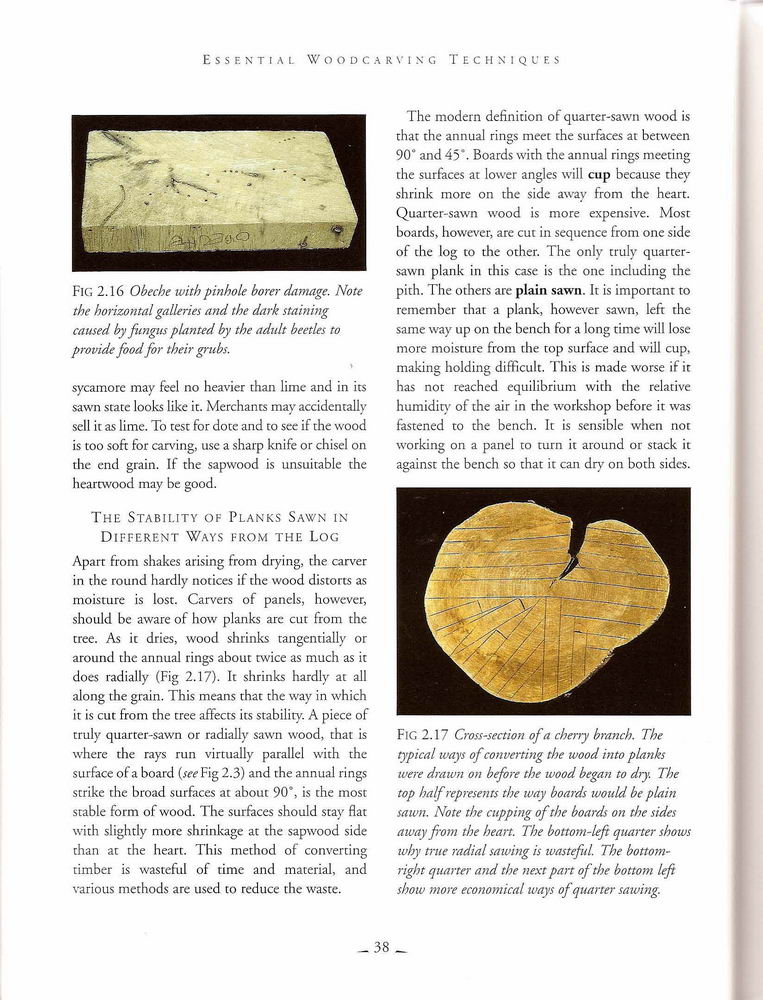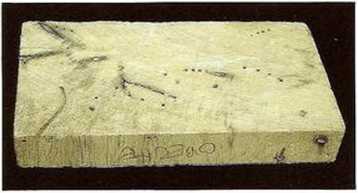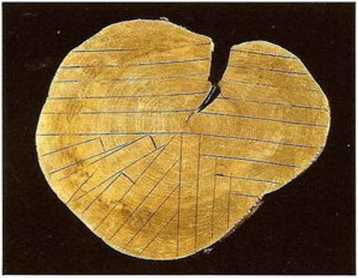essentÊrving°38

Essential W o o d c a R VIN g Techniques

Fic; 2.16 Obeche with pinhole borer damage. NotÄ™ the horizontal galleries and the dark staining caused by fingtis planted by the adult beetles to provide food for their grubs.
sycamore may feel no heavier than limÄ™ and in its sawn scatc looks like it. Merchants may accidcntally sell it as limÄ™. To test for dotc and to sec if the wood is too soft for carving, usc a sharp knife or chisel on the end grain. If the sapwood is unsuitable the heartwood may be good.
The Stabii.ity of Planks Sawn in
DlFFERENT WaYS FROM THE LOG
Apart from shakes arising from drying, the carver in the round hardly notices if the wood distorts as moisturc is lost. Carvers of pancls, howevcr, should be aware of how planks are cut from the cree. As it dries, wood shrinks tangentially or around the annual rings about twice as much as it does radially (Fig 2.17). It shrinks hardly at all along the grain. This means that the way in which it is cut from the tree affeers its stability. A piece of truły quartcr-sawn or radially sawn wood, that is where the rays run virtually parallel with the surface ofa board (*<*<* Fig 2.3) and the annual rings strike the broad surfaces at about 90*, is the most stable form of wood. The surfaces should stay flat with slightly morę shrinkage at the sapwood side than at the heart. This method of converting timber is wasteful of timc and materiał, and various methods are used to reduce the wastc.
The modern definition of quarter-sawn wood is that the annual rings meet the surfaces at between 90* and 45*. Boards with the annual rings mecting the surfaces at lower angles will cup because they shrink morę on the side away from the heart. Quarter-sawn wood is morę expensive. Most boards, howcvcr, are cut in sequcnce from one side of the log to the other. The only truły quarter-sawn plank in this case is the one including the pith. The others are plain sawn. It is imporrant to rcmember that a plank, however sawn, left the same way up on the bcnch for a long timc will lose morę moisture from the top surface and will cup, making holding difficult. This is madę worse if it has not reached equilibrium with the relative humidity of the air in the workshop before it was fastened to the bench. It is sensible when not working on a panel to turn it around or stack it against the bench so that it can dry on both sides.

FlG 2.17 Cross-section ofa cheny branch. The typical ways of cotwerting the wood into planks were drawn on before the wood began to dry. The top half represenrs the way boards would be plain sawn. NotÄ™ the cupping of the boards on the sides away from the heart. The bottom-left Ä…uarter shows why true radial sawing is wasteful. The bonom-right Ä…uarter and the next part of the bonom lefi show morÄ™ economical ways of quarter sawing.
-38 _
Wyszukiwarka
Podobne podstrony:
essent?rving?54 Essential Wo o d c a R VIN g Techniques Fic. 4.1 Various mouldings (from the top): a
essent?rving?72 Essen tial W o o d c a r vin g Techniques Alder {Alnus glutinosa) Pale yellow or pin
essent?rving?84 Essential Woodcarving Techniques Fig 7.7 This is how a piece of card would look if f
essent?rving?78 Essential Woodcarving T e gh N 1 Q U E s FlG 6.9 Eigbteenth-century acanthus from a
Fig. 4 of Venetian foundations, with its short wooden piles, the wooden raft and the masonry socle&n
essent?rving?06 Essential W o o d c a r ving Techniques Inside bevel Blade Shank Tang: tapered, stra
essent?rving?50 Essen tial W o o d c a r vin g Techniques Fig 3.11 Making the stab aa at too shallow
essent?rving?68 E S 5E NTI A L W O O D C A R VIN G TECHNIQLES Fig 5.6 The gouge can removeplenty of
essent?rving?75 C a r vin c Traditional Foliace Fic. 6.4 Copy offijteenth-century vine leaf running
essent?rving?33 C A R VIN G THE HfMAN FIG1R E Fic. 12.13 The clay bead witb most of the muscles. Fig
essent?rving?08 Essen t i a l W o odcarvin c, T e c h n i q u e s Fic 1.5 Backbcnt. FlC 1.4 Left- an
essent?rving?10 Essentiai. Woodcarying Techniques Makes of Tool Maker/brand Country Edge-
essent?rving?14 pp Essential Woodcarvixg Techniques W Fig 1.17 Ttoo grounders. Very narrow old Engli
essent?rving?22 ESSENTIAL W O O D C A R VIN G T E C H N IQ U E S Fig 1.36 It is possible to use the
essent?rving?28 Essential Woodcarving Techniques Phloem or bast Bark Wood or xylem Roots anchor the
essent?rving?36 Essential W o o d c a R VIN G Techxiques accclcratcd process in a chamber wherc che
essent?rving?56 Essential Woodcarvixc Techniques Critical factors in cutting mouldings are the sizes
essent?rving?64 Essential W o o d c a r V in g T e c h niqie s Fic 4.23 A large No. 5gouge shaping t
więcej podobnych podstron